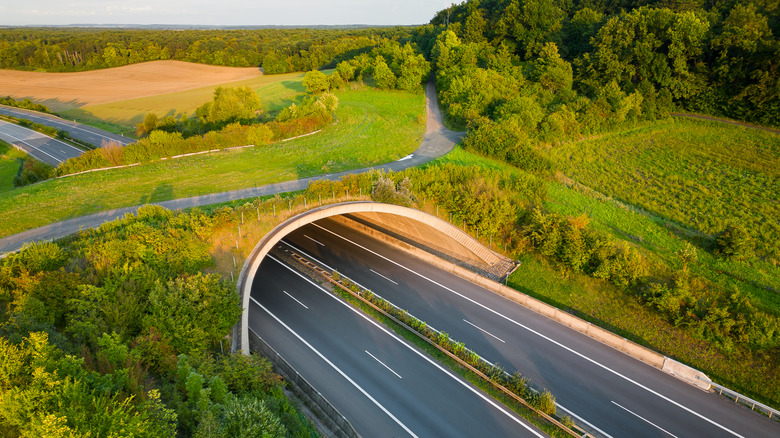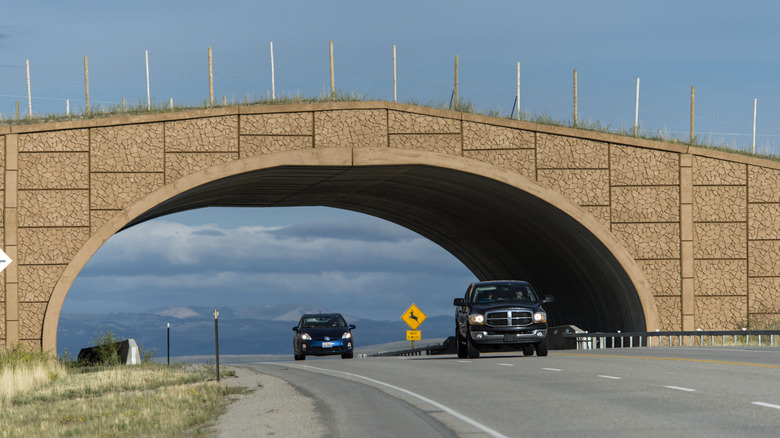What It Means When You See An Unusual Overpass In Colorado That Looks Like A Big Pile Of Dirt
Colorado's massive mountain ranges and forests make it one of the best places in the U.S. to reconnect with nature. It's not uncommon to spot elk roaming along hidden hiking trails like the waterfall-filled Blue Lakes Trail, or see bears at Cheyenne Mountain State Park, which boasts incredible recreation and camping. But even this rugged state has to balance letting visitors experience its nature with protecting important wildlife territory. As highways cut through areas important to its fauna, Colorado has turned to a modern solution that you might drive past without thinking twice about: wildlife overpasses that let animals safely cross while drivers continue their journey uninterrupted.
These overpasses — called wildlife crossings — appear as wide, dirt- and vegetation-covered bridges over busy roadways, where animals can safely cross, particularly during migration periods. As winter's harsher weather approaches, wildlife like deer and elk migrate to lower elevations. Many wild animals also have daily migrations, moving between the woods at night (for shelter) to meadows during the day (for grazing). As more busy roads split the animal migration corridors, they become common sites of collisions. As CDOT Wildlife Program Manager Jeff Peterson told Colorado Outdoors, around 4,000 of these collisions occur every year. That puts people in danger as well as disrupts the animal population: A full 2% of female collared mule deer are killed by vehicle collisions, the Colorado Wildlife & Transportation Alliance reports.
Luckily, the wildlife crossings being built around the state are one of those rare innovations that benefit humans and animals alike, allowing both to cross paths safely. A crossing at Colorado Highway 9, for example, reduced collisions by 92% after five years, a State of Colorado bill reported. In 2022, Colorado passed a bill to fund new wildlife crossings, so travelers may notice more of them popping up along their routes.
Where you might see wildlife crossing over Colorado's highways
Wildlife crossings aren't built at random. The Colorado Wildlife & Transportation Alliance identifies "hotspots" where wildlife are most affected by roadways and where collisions are likely to occur. The Colorado Highway 9 overpass, for example, is a major hotspot for two reasons: It's a winter range area, where animals migrate through, and it often gets black ice or other severe weather, increasing the chance of crashes. Across about a 10-mile stretch of this highway, there are two overpasses, plus five underpasses, dozens of escape ramps, and wildlife guards, Denver7 reported. One of the largest of these overpasses is expected to be completed in December 2025 and will cross I-25, extending across six lanes. It will form a safe crossing on a common route near Monument, Colorado, an underrated town between Denver and Colorado Springs. As these overpasses are under construction, drivers can expect some lane closures and lower speed limits in the work areas.
Travelers can't walk across these crossings themselves. You might, however, be able to spot wildlife on them from pull-outs or while passing through. Elk and deer are frequent crossers, but you're also likely to see coyotes, bears, foxes, and more. If you come to Colorado for its nature and do encounter wildlife, Colorado Parks & Wildlife says that the most important way to protect yourself and the animals is simply to leave them alone. It's also illegal to feed many of them. If you're lucky enough to see a wildlife crossing in action, admire from afar and let the animals stay wild.

